Transit leaders discuss how Remix scheduling software helps them cut costs, improve service, and make their drivers’ lives easier.
When transit agency leaders think about buying software to help their scheduling team, they’re usually hoping to improve the efficiency of the process and the overall quality of their schedules while minimizing the time needed for staff to master the new tool. But what does success actually look like?
We talked to Remix Scheduling customers to better understand how they measure and characterize the improvements they’ve felt in their processes and outcomes.
Same routes. More efficient.

Optimize existing routes with more efficient schedules.
“The runcutting is just a fantastic tool.”
With their bid processes pre-Remix so time-consuming, our customers were never quite sure that the schedules they generated were the best possible, just that they worked well enough. “The runcutting was just a fantastic tool,” David Bruffy says, describing how Remix presents multiple runcut options within minutes. “We could look at multiple ways to do it and come up with the most efficient… Before, we were locked into this spreadsheet — it’s what we had to do because we didn’t have time to look at anything else.” There was no room for error, and no time for optimization.
Remix Scheduling changed that, for David and for other Remix customers across the country. “It’s not just that it’s cut our time,” he says, “it lets us give a better product and job satisfaction to our employees.”
For Delilah Garcia, better schedules means more efficient use of driver resources — critical during an ongoing driver shortage. “I was able to find efficiencies,” she remembers. “I’m going to say a surplus of seven drivers, right when I first put the bid together. I think we had a staff of about 35 employees at the time who were actual driving employees, and seven of those ended up being our first extra boards,” or drivers who are available to take shifts on an as-needed basis.
Delilah is unequivocal about the impact: “So that was huge.”
Reduce the time it takes to run a bid – every time.

Save your staff hours, weeks, and months with more efficient rebids.
“There’s an opportunity cost when you fail to change or you fail to use technology.”
When we talked to our customers about Remix Scheduling, one message came through loud and clear: rebids are time-consuming, and happening with greater frequency as agencies face new challenges like altered commute patterns and driver shortages. Tara Frank, at Tahoe Transportation District (TTD), found herself doing multiple emergency rebids when driver staffing levels came out lower than expected. Delilah Garcia, at North Central Regional Transportation District (NCRTD), observed that there had been an “increased demand for service changes” among the populations her agency serves.
For these agencies and others, using Remix has dramatically cut down on the time it takes to block, runcut, and roster services after a route or schedule change. With Excel and pen and paper, Garcia recalls: “It took me about a month to finish semi-annual operator schedules and runcutting for operators’ bids. So two bids took two months out of my job.” With Remix, she says that time per bid is down to 8 hours’ uninterrupted work.
David Bruffy, the CEO of Mountain Line Transit Authority in West Virginia, has a slightly more conservative estimate: “Typically it would have taken us at least a month to put it together, and now I’m pretty sure it’s less than 40 hours.” But he also notes that the time saved — 75% — has created opportunities for new, innovative programs at the agency. “Before, I was the only person that had the ability to use the GIS system… and that took me away from doing other innovative things. There’s an opportunity cost when you fail to change or you fail to use technology.”
Make rosters your drivers actually want.

Incorporate breaks, schedule weekends off, and keep your drivers happy.
“I wouldn’t want to try to do it manually.”
The persistent driver shortage affecting transit agencies in the wake of COVID-19 has reemphasized what transit professionals always knew: an agency’s most critical resource are its drivers. With driver retention at the highest priority, Remix Scheduling customers looked to the tool to help them come up with schedules that were, as Tara Franks put it, “a little more friendly to drivers.”
With Remix, David Bruffy is able to offer “a five-day-a-week schedule, where everyone has at least one weekend day off and two consecutive days off.” He can plug these requirements into Remix’s runcut generator and view multiple options that maintain the shift elements his drivers value most.
These options help him visualize tradeoffs between efficiency and driver satisfaction, and come up with solutions he might not have otherwise found. “To do that manually…” he says of his driver-friendly schedule, “I wouldn’t want to try to do it. You’d have to have probably two or three people doing nothing else to come up those kinds of solutions.”
Route changes and re-bids? No problem.

Help your staff scope route and schedule changes with ease.
“Information in one place helps us to deal with the increased demand for service changes more efficiently.”
In the past few years, Delilah Garcia has noticed a greater volume of requests for service changes than at any time in her career. Scoping these requests — and ultimately incorporating them into her schedules — is a major part of her job as she tries to keep pace with the changing needs of the communities her agency serves.
The integration of Remix Planning and Remix Scheduling helps with all that: “Having all the data and resources that Remix gives us was important for us, so that we’re able to see where the transit need is — in terms of demographic statistics — without having to check census information and do deep drill-downs to know if it’s true or not. Information in one place helps us to deal with the increased demand for service changes more efficiently.”
Remix transfers any work done in the Planning suite straight into the Scheduling interface. Echoing Delilah’s sentiment, Tara Franks observes: “You’re able to get cross-functional input into the scheduling process without having to start from scratch.”
Even better, the Planning and Scheduling tools are both easy enough to use that agencies can better divide up the task of evaluating potential service changes. As David Bruffy remembers, “Even using geographic information system [GIS] software, analyzing the impact of service changes would just be the most tedious thing in the world. With the user-friendly interface of Remix, I’ve got half a dozen people on staff that can use this tool.”
Want to learn more about Remix Scheduling? Reach out to partnerships@ridewithvia.com.

Via Resource Editor




